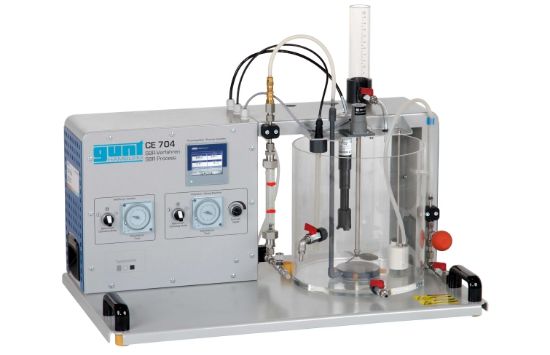The SBR process is a biological, aerobic wastewater treatment process. In contrast to the classic activated sludge process, the individual process steps are not continuous and do not take place simultaneously, but rather are carried out in batches and sequentially in one single reactor.
The reactor is equipped with a compressor for aeration and a stirring machine. The stirring machine ensures sufficient mixing of the reactor contents even in phases without aeration (denitrification). At the end, the treated water (clear water) is extracted from the reactor and collected in a tank. This is done with a floating device, as is typical for the SBR process. Above the reactor is a device for metering an external carbon source (e.g. sugar solution) if required.
Timers for the compressor and stirring machine make it possible to set the aeration phases (nitrification) and mixing phases (denitrification) individually. The oxygen concentration, pH value and temperature in the reactor are measured. A digital process controller continuously displays the measured values and the speed of the stirring machine. The process controller has a touch screen and also functions as a controller for the oxygen concentration during the aeration phases.
Activated sludge (e.g. from a wastewater treatment plant) is required for the experiments. Table sugar (sucrose) can be used as a carbon source for the synthetic wastewater. The following parameters must be determined in order to analyse the experiments:
total organic matter
- BOD5 or COD or TOC
nitrogen concentrations
- NH4-N: ammonium
- NO2-N: nitrite
- NO3-N: nitrate

SBR process
The SBR process is a biological, aerobic wastewater treatment process. In contrast to the classic activated sludge process, the individual process steps are not continuous and do not take place simultaneously, but rather are carried out in batches and sequentially in one single reactor.
The reactor is equipped with a compressor for aeration and a stirring machine. The stirring machine ensures sufficient mixing of the reactor contents even in phases without aeration (denitrification). At the end, the treated water (clear water) is extracted from the reactor and collected in a tank. This is done with a floating device, as is typical for the SBR process. Above the reactor is a device for metering an external carbon source (e.g. sugar solution) if required.
Timers for the compressor and stirring machine make it possible to set the aeration phases (nitrification) and mixing phases (denitrification) individually. The oxygen concentration, pH value and temperature in the reactor are measured. A digital process controller continuously displays the measured values and the speed of the stirring machine. The process controller has a touch screen and also functions as a controller for the oxygen concentration during the aeration phases.
Activated sludge (e.g. from a wastewater treatment plant) is required for the experiments. Table sugar (sucrose) can be used as a carbon source for the synthetic wastewater. The following parameters must be determined in order to analyse the experiments:
total organic matter
- BOD5 or COD or TOC
nitrogen concentrations
- NH4-N: ammonium
- NO2-N: nitrite
- NO3-N: nitrate
